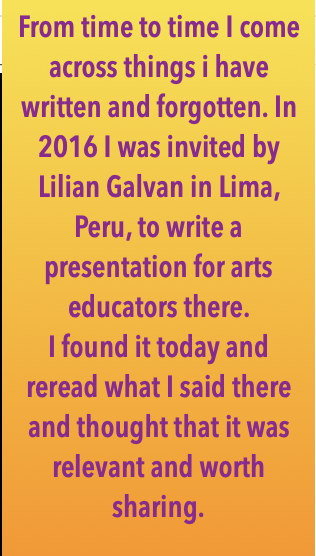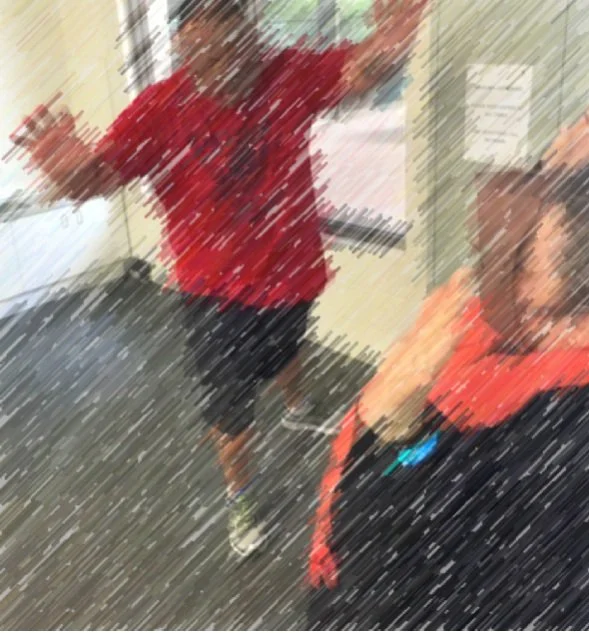Drama Tuesday - A Time for Giants
/The challenges for teachers facing change
The playwright José Rivera in the introduction to Giants Have Us in Their Books tells of his four year old daughter’s observation
“if we have giants in our fairy tales, then giants must have us in theirs!”.
Imagine how giants would tell their children of this moment in the history of arts and culture education in Peru.
Take a moment to dream of arts and culture becoming the work of every teacher, becoming the fabric of every lesson, becoming the living testament of every young person. Imagine how arts and cultural actions embody learning. Imagine how introducing an embodied change in arts and cultural curriculum opens possibilities beyond what we can imagine. For Deleuze and Guattari, becoming is a process where bodies affect other bodies and are transformed((1987 [2012])). In short it is a human process – a people focused transformation.
Of course, there are and will be challenges.
In the ancient stories of many cultures, we are told to be afraid of giants. They were the villains of the story. But the biggest giant of the moment is the fear of change. Fear is a basic human emotional response. Change is about leaving behind our comfort zones and facing complexity, uncertainty and doubt – and I see this in my teacher education students when they are faced with the concepts of teaching the arts themselves. I begin by recognising that for many of my students, overcoming fear of change needs acknowledgment of stress and finding ways of managing stress. In part I do this by chunking information, translating the edu-speak and jargon, by relating experiences to authentic situations. I have learnt through working as a curriculum change leader that there is a need for structure and tools; but most importantly, there is the simple but complex recognition that change is about people. Change for us all is a journey not a destination and curriculum change is (hopefully a guided journey. Fear of change can be about the unknown; it can be about fearing failure; and it can be about fearing success.
To get past moments of fear we need to remember that enacting an arts and cultural education curriculum is a time for us to be giants. The concept of an arts and cultural curriculum is a big idea – a giant idea – and it does not need timidity or apology. Shout from the rooftops. Create a storm of interest and passion. Lead the change. Become the change.
Our pedagogy leads the way for managing change.
We must be true to our principles for arts education.
The research I have done about Arts Education (e.g. Pascoe 2013; Wright, et al. 2006) has identified that the markers of quality are founded on principles of:
student identity and agency – their sense of becoming;
co-construction of meaning and learning;
learning environments that support creativity, imagination and innovation; and,
seeing students (and teachers) as artists and audiences.
Therefore leading teachers towards successful arts teaching needs us to address these same principles.
If these are the principles of arts and culture education for students then they should be the principles for engaging teachers. Let me put them again as questions for us who lead the enactment of arts education:
How do we help teachers in every classroom find their own identity, develop their own voice and agency, help their own sense of becoming?
How do they co-construct with other teachers meaning making arts education for themselves and their students?
How do we provide supportive learning environments?
How do we help teachers see themselves as artists and audiences?
Becoming the curriculum change we envision is about understanding the specific pedagogies of the arts – the specific ways that we learn the arts through embodied learning, through practical, hands on ways, through ways that seek to integrate and make connections.
There is a time for giants.
In the 2015 Perth International Arts Festival, the Royale de Luxe Giants visited. They walked the streets of this modern city and set a tumble of excitement. Thousands of people poured into the streets to watch, to walk to be with the Little Girl and the Diver. In the beating summer heat they laughed and maybe even cried a little on the journey of the giants. Most importantly, they embodied the idea of imagination and wonder. It was a big event that caught fire.
Just as we are as individuals in a process of becoming, arts and culture education is in a similar process of becoming. What emerges will not be fixed of static but richly evolving, richly possible. And who are the people to make that happen – keep happening?
You know the answer.
Roar, roar like giants – for arts and culture education.
Bibliography
Deleuze, G. and F. Guattari (1987 [2012]). A thousand plateaus. London, Continuum International Publishing Group.
Pascoe, R. (2013). Dynamic Markers for Arts Education in Schools. International Yearbook for Research in Arts Education 1 | 2013. E. Liebau, E. Wagner and M. Wyman. Münster, Waxmann: 47-62.
Wright, P. R., R. Pascoe, J. Dinham, J. MacCallum, K. Grushka, T. Church and A. Winteron (2006). From Behind the Mask: Revealing Visual Education. Research Report to The National Review of Education in Visual Arts, Craft, Design and Visual Communication. Perth, CLCD, Murdoch University: National Review of Visual Education.









